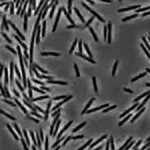 Recently I looked at a couple of studies, from researchers at the University of Lincoln and Sheffield respectively, that explored how to successfully and safely manage swarms of robots.
Recently I looked at a couple of studies, from researchers at the University of Lincoln and Sheffield respectively, that explored how to successfully and safely manage swarms of robots.
They developed automated ways that groups of up to 600 robots can be coordinated successfully. As robots are both growing in numbers and increasingly collaborative, this is clearly an issue that is vital to the successful utilization of robots.
The Sheffield team took their cue from the way swarms behave in nature, but a team of Duke University researchers have gone a step further via a study whereby they report on the robots microbes they engineered so they can’t run away from the proteins they’re protected by.
Engineering swarmbots
The ‘bots’ are designed for things such as the prevention of GM organisms from spreading out of control, but could also be deployed in bacteria to allow them to respond to changes in their environment.
“Safety has always been a concern when modifying bacteria for medical applications because of the danger of uncontrolled proliferation,” the authors say.
“Other labs have addressed this issue by making cells rely on unnatural amino acids for survival or by introducing a ‘kill switch’ that is activated by some chemical,” they continue. “Ours is the first example that uses collective survival as a way of intrinsically realizing this safeguard.”
Artificial E.coli
The researchers developed an artificial, non-pathogenic strain of E.coli so that it would produce a chemical called AHL. They also manipulated the cells so that a high concentration of AHL would cause them to resist antibiotics.
So, when the population of E.coli is particularly dense, this resistance keeps them alive, even when the antibiotic would normally kill them.
The approach was tested by confining a large amount of bacteria to a capsule and dousing it in antibiotics. The E.coli would remain safe so long as they remained together in their container. If they escaped, they would be killed by the antibiotic.
Whilst not practically replicable, the researchers believe it does nonetheless represent a firm proof of concept that can then be tested further in other circuits.
“In general, this concept does not depend on the use of antibiotics,” they say. “There are multiple directions we are hoping to follow with this platform. We’re using non-pathogenic E. coli, but we hope to demonstrate that the same concept can be established with a probiotic strain of bacteria.”
“We can imagine programming probiotics that can respond to changes in their environmental conditions,” the team continue. “That response could include delivering proteins or chemicals to modulate the microbiome.”
The team believe the approach could also be used to help the body respond to ‘intruders’. They want to program cells to better respond to signals produced by bacteria so that the virulence of an attack is limited.
“This is the foundation,” they conclude. “Once we’ve established the platform, then we have the freedom to introduce whatever proteins we choose and allow these cells to engage in many different applications.
It’s certainly an interesting approach and it will be fascinating to see where they go with it. Check out the short video below for more information about their work.